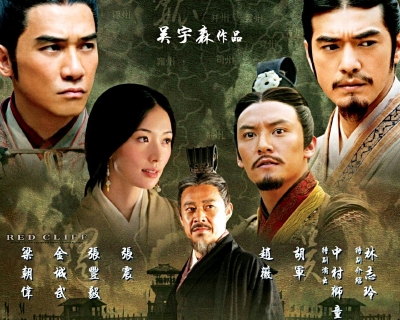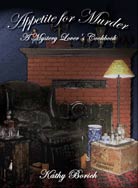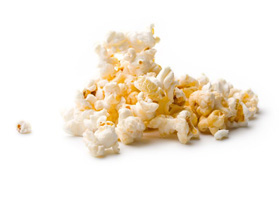Red Cliff, Parts I and II: Lantern Festival Rice Ball Recipe
Year Released: 2010
Directed by: John Woo
Starring: Tony Leung, Takeshi, Kaneshiro, Zhang Fengyi
(Not Rated, 280 min.)

"As swift as the wind, as gentle as a forest, as fierce as fire, as firm as a mountain." Sun Tzu : The Art of War
It’s been so long since I’ve handed out a five star rating for a film, some of you might have wrongfully concluded that I use a 4 star scale. Well, this two part Asian release by John Woo has it all, an epic war film on a par with Gone with the Wind or Excalibur, the classics Beowulf or The Iliad. It is fierce with fighting, blood, and death, with no post-modern apologies.
Not one, but many heroes, so varied and complex, you almost need your own Red Cliff Cliff Notes to make sense of it all. (Don’t confuse these films with the 2009 American theater release of the same name that merged the over 4 hour two part series into a single film under 2 ½ hours. That film I saw and liked, but it definitely was only a four star – too much action and not enough development of the depth and texture that underscore the longer 2 part film now available for streaming through Amazon.
Like a good sauce, this tales insinuates itself and by the second part you will even be able to distinguish the characters from each other, despite the subtitles, the plethora of names beginning with “Z,” and those confusing fu man chu mustaches they all sport – except for the girls, that is.
As a help, the five chief characters pictured above are, from left to right:
Yhou Yu – Grand Viceroy to Sun Quan and husband of the exquisitely beautiful and graceful Xiaoqiao
Xiaoqiao – Wife of the Viceroy, the face that launched a thousand ships, Asia’s version of Helen of Troy
Cao Cao – Their main antagonist, the Han emperor’s prime minister turned general who starts it all from a deadly brew of ambition and thwarted love
Sun Quan – One of two rebel southern warlords embattled against general Cao Cao
Zhuge Liang – My overall favorite character, the chief strategist and diplomat for the other southern warlord fighting Cao Cao, Lie Bei, not pictured here.
Notice that the four larger characters are all on the same side. General Cao Cao, beneath them at the center of it, is somewhat smaller. His placement and size are both literal and figurative. He is, literally, at the center of it all, beneath them in honor and dignity, and smaller in character as well.
This film works well in the home theater format, where you can stop and rewind, if you wish, or even watch the whole thing over and over again, because it is like a fine violin that sounds better each time it is played. In that sense it reminds me of Shakespeare, a writer whose rich talents were so deep, that as many times as I shepherded my students through his texts, I always found something new with each reading.
Of course, Woo’s film isn’t something just dried up literary hags would love; it is a rip roaring elongated battle, complete with ancient “psyops” (psychological operations planned to convey misinformation information to the enemy for tactical advantage), courtesy of Sun Tzu’s The Art of War. And it is over the top, too, but not to the extent of those other Asian imports such as Crouching Tiger and Hidden Dragon or my favorite director, Zhang Yimou’s Hero or House of Flying Daggers, where you really have to suspend your disbelief along with the force of gravity which does nothing to restrain those cinematic warriors.
Red Cliff’s warriors are pretty awesome even if they can’t fly. One of them, Zhao Yun, blood brother to his warlord Lui Bei, is able to cut down about twenty-five of Cao Cao’s men as he rescues Lui Bei’s heir from the enemy. The heir, of course, is a round-cheeked infant who alternately smiles and wails in typical baby fashion, oblivious to the life and death struggle going on around him. Wrapped in a cloth, fortunately bloodied not with his own but that of the enemy, the little bundle is tucked and shifted around like a football as his champion fights his way to the goal line.
Even the art of diplomacy is surreal. Not the choreographed photo ops with pasted on smiles and prearranged conclusions we are all used to today, but where deals are sealed with quins, ancient stringed instruments that tell us more about the heart, soul, and tactical leanings of their players than any words could. At the end of the extemporaneous duet between Viceroy Yhou and Diplomat Liang, a stringed conversation not unlike the classic dueling banjos in Deliverance, even the viceroy’s wife knows whether he will or will not join the Alliance against Cao Cao. But what really seals the deal is the birth of the viceroy’s foal, where the farm boy roots of Liang help him assist in a dangerous breech birth.
Or what about a tiger hunt to screw southern warlord Sun Quan’s courage to the sticking point so he can defy his pacifist leaning counsel and join the alliance? Not to mention Sun Quan’s sister Sun Shucai, the capable and headstrong tomboy who infiltrates the enemy camp as a spy and sends back her reports via carrier pigeon.
These twin films are a delight to the senses, where even human slaughter has its own sort of beauty, a cerebral study of The Art of War that makes the classic Spartan/Persian Battle of Thermopylae via 300 fame look like child’s play.
—Kathy Borich
Film-Loving Foodie
Before the final battle, where the greatly outnumbered Allies will face the mighty forces of Cao Cao, the underdog rebels celebrate the winter solstice with the ritual food of the Lantern Festival, Chinese Rice Balls, symbols of the moon and a happy future. Of course, their future is certainly not assured and happiness, even life, hangs in the balance, like the celebrated moon, which is nowhere to seen, since their celebration is at midday. But let’s not quibble.
It is a symbol of their unity, their loyalty and courage that they share in this feast together, almost like the religious ritual of the Last Supper, where Christ broke bread and drank wine with his Apostles.
Here, however, it is the generals who bring their offerings to the Viceroy who will lead them to death or victory the next day. His bowl overflows with the translucent orbs symbolic of their shared destiny.
So may your bowl and your happiness overflow. Enjoy these exotic sweet and sticky treats.
Lantern Festival Rice Balls
Most holiday celebrations have at least one special food associated with them; this is true of the Chinese Lantern celebration, which coincides with the first full moon of the Chinese year. To celebrate the Lantern Festival, families often dress in white, and lanterns are hung in honor of the moon and to shine the way to a happy future. And, of course, you must eat during any celebration, and the delicacy of choice for the Lantern Festival is Chinese rice balls, little white moonlike treats.
Ingredients
- 2 sticks of butter (margarine will work) softened
- 1 ½ tbsp. black sesame powder
- 8 oz. granulated sugar
- 4 ½ cups of sticky rice powder
- 1 tbsp. rice wine
- 1/4 cup boiling water
- 1/4 cup cool water
How to Make Chinese Rice Balls
Step 1. Combine 2 sticks of softened butter or margarine, black sesame powder, granulated sugar and rice wine together thoroughly. Note: You can find black sesame powder and sticky rice powder at Asian markets, or check the Resources at the end of this article.
Step 2. Roll the mixture from Step 1 into small balls approximately ½ inch in diameter. Set aside.
Step 3. Mix ½ cup sticky rice powder with ½ cup boiling water. Stir until blended and form into a 1-inch-thick circle.
Step 4 . Boil the dough circle in a pot of water until it rises to the top. Remove and let set until it is cool enough to handle.
Step 5 . Add the rest of the sticky rice flour and cool water and knead until the dough is smooth.
Step 6. Pull off pieces of the dough and make into 1-inch balls. Push a sesame ball into the center of each rice ball and seal closed.
Step 7 . Place the rice balls into boiling water and boil for 1 minute after the balls rise to the top.
Recipe Source: eHow.com



 Rainy Day Rentals
Rainy Day Rentals